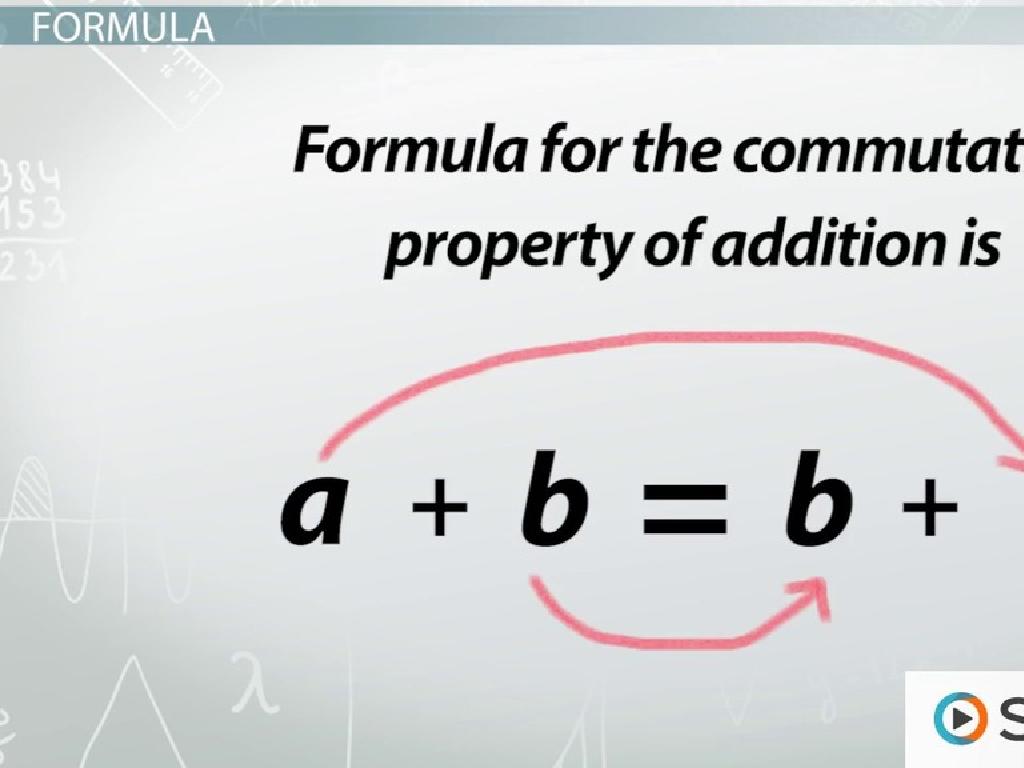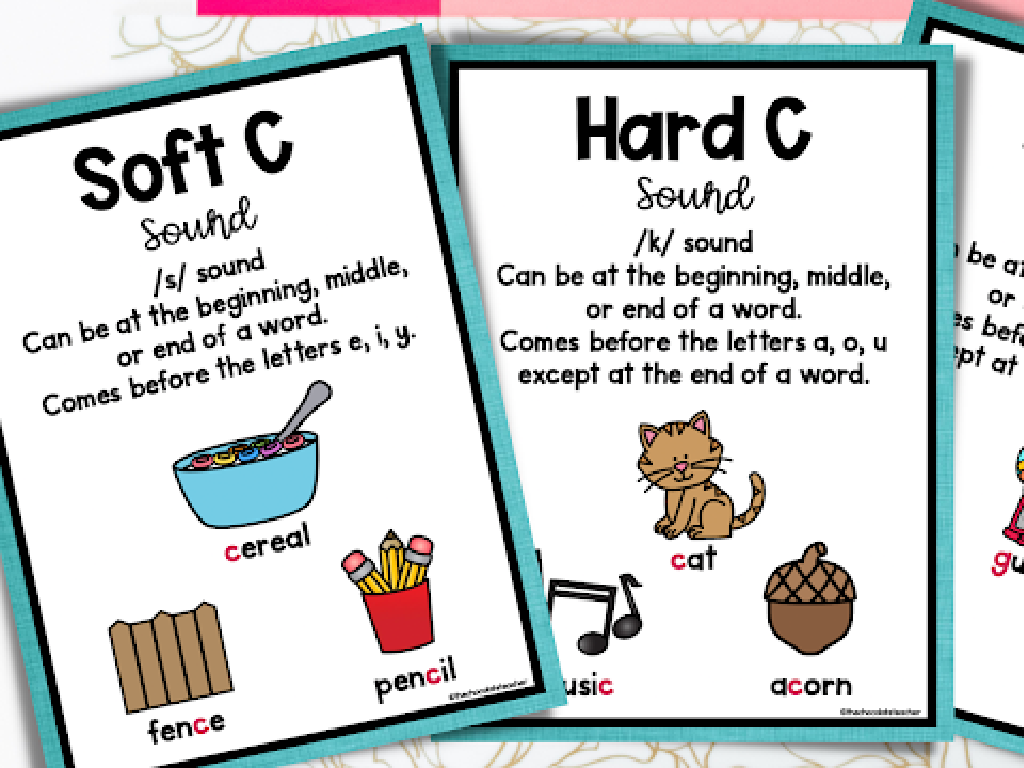Understanding Opposite Integers
Subject: Math
Grade: Sixth grade
Topic: Integers
Please LOG IN to download the presentation. Access is available to registered users only.
View More Content
Understanding Opposite Integers
– Define integers
– Integers include whole numbers and their negatives
– Explore positive numbers
– Positive numbers are above zero
– Explore negative numbers
– Negative numbers are below zero
– Opposites on the number line
– Every number has an opposite, e.g., -3 and +3
|
This slide introduces the concept of integers to the students, emphasizing the inclusion of both positive and negative whole numbers as well as zero. Begin by defining integers and explaining that they are not fractions or decimals. Highlight that positive numbers are to the right of zero on the number line and represent quantities greater than zero, while negative numbers are to the left and represent quantities less than zero. Discuss how every positive number has an opposite negative number, and these are the same distance from zero but in opposite directions on the number line. Use real-life examples such as temperatures above and below zero, or debts (negative) and credits (positive) in banking. Encourage students to think of their own examples of opposites.
Exploring Integers
– Integers: Positive and Negative
– Whole numbers without fractions, including negative numbers, zero, and positive numbers.
– The Number Line representation
– A line with numbers placed at equal distances, used for comparing and ordering integers.
– Positive integers: Examples
– Examples include 1, 2, 3 (counts of objects, points scored).
– Negative integers: Examples
– Examples include -1, -2, -3 (temperatures below zero, debt).
|
Integers are the set of whole numbers that include negative numbers, zero, and positive numbers. They are fundamental in math as they help students understand basic arithmetic operations within a broader number system. The number line is an essential visual tool that helps students grasp the concept of ordering and comparing integers. Positive integers can represent things like counts of objects or points in a game, while negative integers can represent temperatures below zero or amounts of debt. Encourage students to think of their own examples of positive and negative integers from everyday life.
Opposites Attract: Understanding Opposite Integers
– What are opposite numbers?
– Opposite numbers are pairs that, when added, equal zero. For example, -3 and 3.
– Finding an integer’s opposite
– To find the opposite, change the sign: the opposite of -5 is 5.
– Opposites in real-life scenarios
– Temperatures above/below zero, gains/losses in points.
– Opposite integers on a number line
– Visualize opposites as equal distances from zero.
|
This slide introduces the concept of opposite integers, which is fundamental in understanding integers as a whole. Start by explaining that opposite numbers are two numbers that have the same distance from zero on the number line but are in different directions. Emphasize that the sum of a number and its opposite is always zero. Provide students with clear examples, such as temperatures above and below zero or points scored and lost in a game, to illustrate the concept in a context they can relate to. Encourage students to practice finding opposites and to represent them on a number line for a visual understanding. This will set the groundwork for future topics like adding and subtracting integers.
Adding Opposite Integers
– Rules for adding integers
– Use ‘+’ for same signs, ‘-‘ for different
– Adding opposites equals zero
– Opposite integers cancel each other out
– Practice with opposite integers
– Solve 5 + (-5) or -3 + 3 as examples
|
This slide introduces students to the concept of adding opposite integers. Start by explaining the rules for adding integers, emphasizing that when the signs are the same, we add the numbers and keep the sign, but when the signs are different, we subtract the numbers and keep the sign of the larger absolute value. Highlight that adding opposite integers, such as 5 and -5, will always result in zero, a concept known as additive inverse. Provide practice problems for the students to apply this rule and solidify their understanding. Encourage students to think of real-life scenarios where this might apply, such as gaining and losing points in a game.
Subtracting Integers
– Steps to subtract integers
– To subtract, add the opposite of the number
– Subtract using a number line
– Visualize subtraction as distance between points
– Relate subtraction to opposites
– Understand subtraction as adding the inverse
– Practice with examples
|
This slide introduces students to the concept of subtracting integers. Start by explaining the steps to subtract integers, which involves adding the additive inverse (or opposite) of the number being subtracted. Demonstrate the use of a number line to help visualize this process, showing how subtraction can be seen as finding the distance between points. Emphasize the relationship between subtraction and opposite integers, explaining that subtracting a number is the same as adding its opposite. Provide several practice examples for students to apply these concepts, and prepare to guide them through the process during class. Encourage students to think of real-life scenarios where they might need to subtract integers.
Real-World Applications of Opposite Integers
– Temperature: Zero as a reference
– Understand temperatures above/below zero (e.g., 5°C vs. -5°C)
– Elevation: Sea level comparison
– Compare elevations above/below sea level (e.g., – Dead Sea vs. Mt. Everest)
– Bank Accounts: Tracking money flow
– Deposits increase balance, withdrawals decrease it (e.g., +$50 deposit vs. -$50 withdrawal)
– Opposites help in understanding changes
|
This slide aims to show students how opposite integers are used in everyday life. Temperature is a common example, with zero degrees as a starting point to measure warmth or coldness. Elevation is measured with sea level as the reference; locations can be above (positive integers) or below (negative integers). Bank accounts use positive numbers for deposits and negative for withdrawals, helping to track the flow of money. These real-world examples will help students grasp the concept of opposites in a practical way. Encourage them to think of other examples where opposites are used to describe changes or differences.
Class Activity: Integer Scavenger Hunt
– Find opposite integer pairs
– Create your own opposite integers
– Think of temperatures, elevations, or debts and credits
– Share findings with the class
– Understand opposites concept
– Opposites are equal distance from zero on a number line
|
This interactive activity is designed to help students recognize and understand opposite integers in a fun and engaging way. Set up pairs of opposite integers around the classroom before the class starts. These can be on sticky notes, flashcards, or objects that represent integers like thermometers or number lines. Encourage students to find these pairs and then create their own examples, which could be related to real-life situations like temperatures or financial transactions. After the scavenger hunt, have students share their findings with the class to reinforce their understanding. This will also provide an opportunity for peer learning. As a teacher, be prepared to guide the discussion and correct any misconceptions. Possible activities could include matching games, creating a human number line, or drawing their examples on the board.
Wrapping Up: Opposite Integers
– Recap: What are opposite integers?
– Opposites are pairs of numbers that, when added, equal zero, e.g., -3 and +3.
– Why integers matter in math
– Understanding integers is crucial for algebra and real-life applications.
– Homework: Practice worksheet
– Complete the worksheet on identifying and working with opposite integers.
– Be prepared to discuss answers
– We’ll review the worksheet in class, so bring your questions!
|
As we conclude today’s lesson on opposite integers, remind students of the key concept that opposite integers are pairs of numbers that add up to zero. Emphasize the importance of integers in various aspects of math, including algebra and beyond. For homework, assign a worksheet that reinforces today’s lesson, ensuring students practice identifying and using opposite integers. Encourage them to try their best and be ready to discuss their answers and any difficulties they encountered during the next class. This will help solidify their understanding and prepare them for more complex mathematical concepts.






